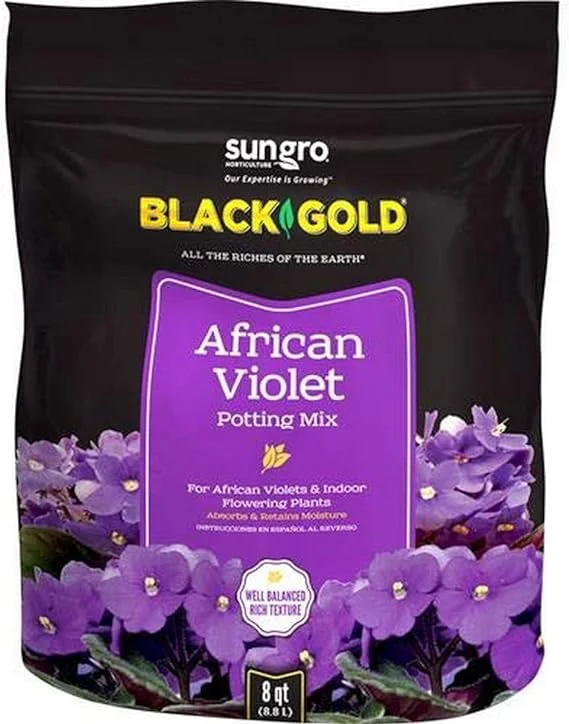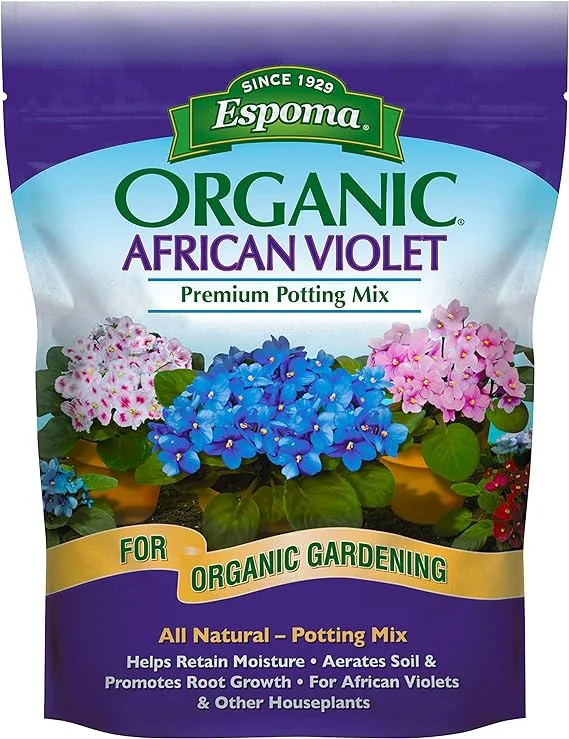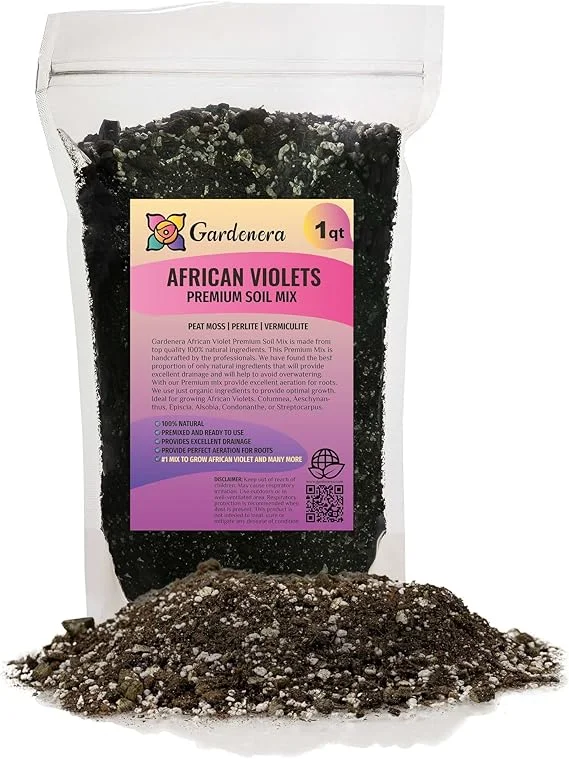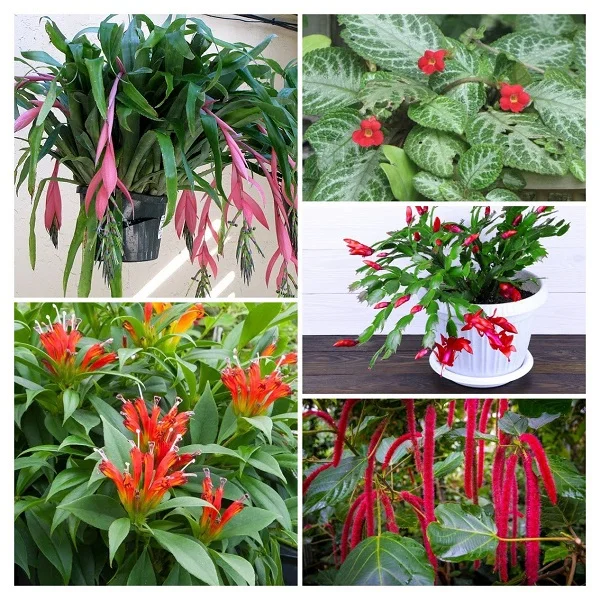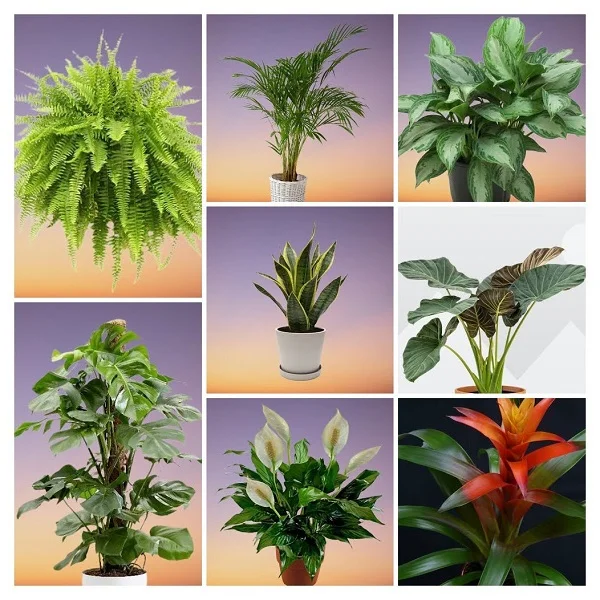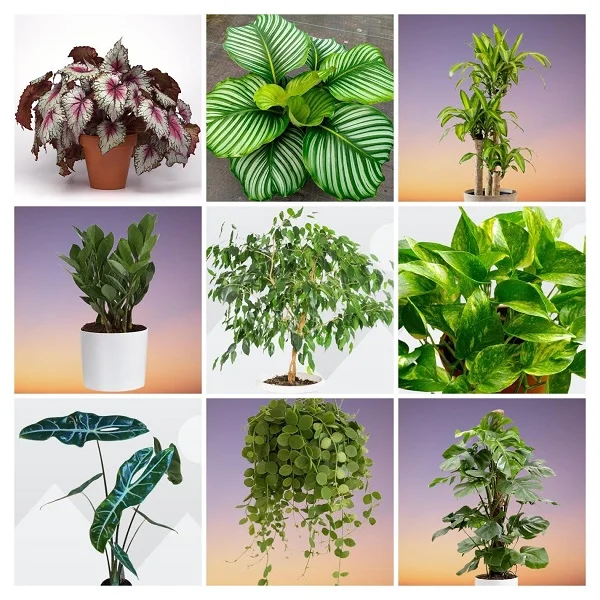Flame Violet (Episcia cupreata) Care Indoors, Common Problems & Solutions
Some links in this post may be affiliate links
Flame Violet (Episcia cupreata) grows best in bright indirect light, warm and humid conditions and consistently moist, fertile, well-drained soil coupled with fortnightly feeding in the growing season.
Episcia cupreata is a fantastic choice for indoor plant lover. In this guide, we will cover everything you need to know about growing and maintaining Flame Violet indoors, from lighting and watering needs to propagation and common problems.
Flame Violet Episcia is one of the best flowering plants on account of its large leaves quilted with silvery or pale-green veins and tubular orange-red flowers which are yellow-eyed.
Due to its high requirement for high humidity, it may be difficult to grow as a stand alone plant or in a hanging basket. However, Flame Violet Plant is an excellent ground cover between taller plants where it can enjoy the increased humidity in the group of plants.
Though an attractive trailing plant, it is not as popular as its well-known relative, the African Violet. This is due to its requirement for highly humid conditions which places it among the popular plants for the bathroom, kitchen, laundry area and other moist places in the home.
The Flame Violet Plant produces runners which root in surrounding soil where they form plantlets that are used for propagation.
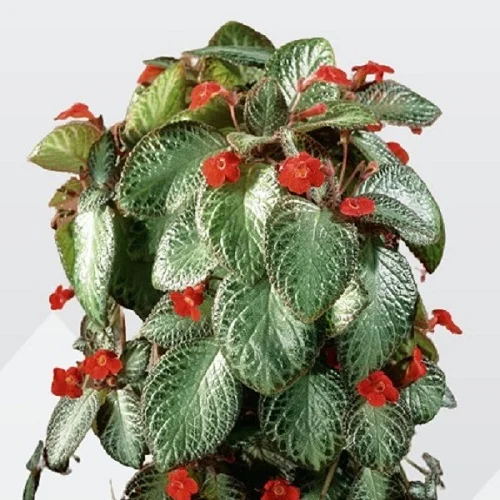
Botanical name: Episcia cupreata
Family: Gesneriaceae
Common names: Flame Violet, Flame Violet Episcia, Violet Flame Plant
Origin
Episcia cupreata is a perennial flowering plant which is native to Brazil, Columbia and Venezuela.
How big do Episcia cupreata get?
Episcia cupreata can grow to a height of 10-12 inches and a spread of 18-24 inches. It has a moderate growth rate, growing 4-6 inches per year.
Varieties
Flame Violet Plant Varieties include many hybrids like Amazon, Metallica, Cleopatra, Harlequin and Acajou among others.
Is Flame Violet toxic to pets?
As listed by American Society for the Prevention of Cruelty to Animals, Flame Violet Episcia is non-toxic to both humans and pets. It is safe for cats, dogs and other pets.
Related Plants
Flame Violet care is similar to that of its close relatives African Violet (Saintpaulia ionantha), Cape Primrose (Streptocarpus hybrida) and Gloxinia (Sinningia speciosa).
Where to Buy Flame Violets
Flame Violets are a spectacular addition to any collection. You may acquire these plants from Etsy (Link to Etsy).
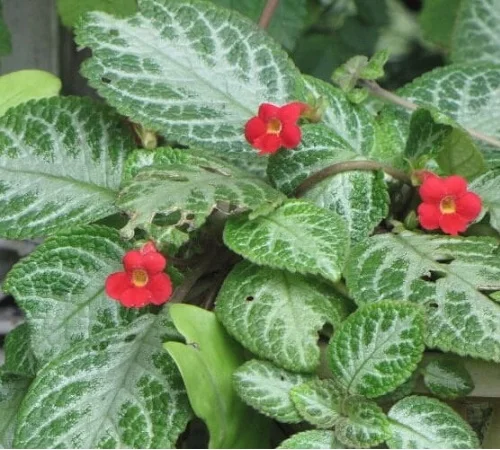
How to care for Episcia cupreata indoors
Caring for Episcia cupreata indoors entails giving it bright indirect light, average warmth of 15-270C, humidity of 60-70% and consistently moist, rich, well-drained soil coupled with fortnightly feeding in spring and summer.
Flame Violet Plant care requires repotting only when extremely pot-bound as it blooms best when root-bound. Regular pruning is needed to keep the plant neat as well as encourage a bushy growth. Keep reading for more on these growing conditions and how to achieve them.
Light Requirements
How much light does Episcia cupreata need?
Episcia cupreata thrives in bright indirect light (dappled light). Place it infront of a large, brightly-lit window. Keep it away from direct sunshine to avoid scorching of the leaves.
If light is too little, the plant will be leggy and will not flower. Therefore, you may grow the plant under grow lights if the natural lighting is not sufficient.
Rotate the pot regularly to ensure that the plant is receiving light on all sides for uniform growth and prevent leggy growth.
Watering
How often do you water Flame Violets?
Do not water Flame Violets on a schedule to avoid either overwatering or underwatering both of which are detrimental to the growth of the plant.
Water your Flame Violet liberally in spring and summer and allow the top 1-2 inches of soil to dry out between waterings. Maintain the soil consistently moist but not soggy to prevent yellowing leaves and rotting stems.
Decrease watering in fall and winter to keep the soil slightly moist as growth is reduced at this time. Do not allow the soil to dry out completely as it can lead to wilting and leaf drop.
Use room-temperature, filtered, or dechlorinated water to avoid stressing the plant. Avoid wetting the leaves to minimize fungal issues; water at the base of the plant.
Make sure that the pot has a drainage hole and the soil is well-draining to avoid getting soggy soil which can lead to root-rot and death of the plant.
Temperature and Humidity
What temperature do Episcia cupreata like?
Episcia cupreata likes a temperature of 15-270C with a minimum of 130C. Protect it from drafts emanating from AC units, windy doors and windows, heat sources and others to prevent slow growth, wilting, and leaf fall.
Flame Violet flourishes in a humidity of 60-70%. Too low humidity may lead to brown leaf tips and edges. To increase humidity, set the pot on a wet pebble tray or use a cool mist humidifier. You may grow the plant in a well-lit bathroom, kitchen, laundry area and other humid places in the home.
Avoid misting and ascertain that there is good air flow for the plant to prevent fungal diseases.
Fertilizer
What is the best fertilizer for Episcia cupreata?
Feed your Episcia cupreata with a phosphorous-rich, water-soluble fertilizer every 2-3 weeks in spring and summer to promote flowering. Avoid too much fertilizer as it can cause leggy growth.
Stop feeding in fall and winter as growth is minimal at this time, therefore, feeding can result in fertilizer burn and death of the plant.
Every 1-2 months, flush out accumulated salts from the soil by running a stream of water through the soil until it drips through the drainage hole.
Potting Soil
What kind of soil does Episcia cupreata need?
Episcia cupreata soil should be loose, well-drained and rich in organic matter. African violet potting mixes are perfect for these plants.
Repotting
When to repot Episcia cupreata
Repot your Episcia cupreata at the beginning of the growing season (spring) only when the plant becomes extremely pot-bound. Being pot-bound encourages flowering.
How to repot Flame Violet
- At least one day before repotting, thoroughly water the plant to make it easier to repot as well as reduce transplanting shock.
- Choose a pot one size larger than the current one that has a drainage hole to avoid getting soggy soil. Check out these self watering planters on Amazon.
- Fill the pot halfway with a loose, well-draining soil like an African Violets potting mix and slightly moisten it.
- Carefully slip the plant out of its current pot, loosen the soil around the roots and cut away dead roots.
- Place the plant in the center of the pot and continue filling the pot while lightly firming the soil around the plant.
- Maintain the plant at the same soil level as it was in the previous pot to prevent rotting.
- Wet the soil thoroughly and replace the plant to its usual spot.
Pruning & Maintenance
How do you prune Flame Violet Episcia?
Pruning Flame Violet Episcia involves:
- Removal of dead blooms and leaves to maintain the plant neat and tidy as well as discourage pest and disease infestations.
- Pinching off the growing tips in young plants to encourage a bushy and compact growth.
- Cutting back the plant after flowering to 1/2 of its height to encourage new growth from which the flowers arise.
Regularly clean the leaves with a soft brush to get rid of dust and also reduce pest and disease infestations.
How do you get a Flame Violet Episcia to bloom?
- Provide it with bright indirect light through out.
- Keep the soil consistently moist in spring and summer and slightly moist in fall and winter. Avoid soggy and dry soil at any time.
- Protect it from drafts and maintain an average warmth of 15-270C.
- Maintain a humidity of 60-70% as it does not like dry air at all.
- Feed it with a phosphorous-rich fertilizer every 2-3 weeks in spring and summer but do not feed in fall and winter.
- Avoid too frequent repotting at it blooms best when slightly pot-bound.
- Cut it back after flowering to encourage new growth as this is where the flowers emerge from.
- Routinely check underneath the leaves for pests and carry out timely control measures.
Propagation
How do you propagate Episcia cupreata?
Episcia cupreata (Flame Violet) propagation is best done from leaf cuttings, stem cuttings or by plant division at the beginning of the growing season (spring).
Learn how to propagate Episcia cupreata (Flame Violet) in 5 easy ways.

Episcia cupreata Problems & Remedies
Episcia cupreata (Flame Violet) problems are brown leaves, lack of flowers, yellow leaves, wilting and drooping leaves, drooping leaves, leggy growth, brown leaf tips and edges, pests and diseases among others. Keep reading for more on these problems, their remedies and solutions.
Brown leaves
Why are my Flame Violet leaves turning brown?
Some of the causes of browning leaves on your Flame Violet are overwatering, underwatering, soggy soil, direct sunlight, and salts buildup.
How to fix it
Overwatering: Water only when the top 1-2 inches of soil dry out. Do not water on a schedule.
Underwatering: Maintain the soil consistently moist in the growing season and slightly moist in the cold season. Never allow the soilball to dry out completely.
Soggy soil: Use a pot with a drainage hole and well-draining soil.
Direct sunlight: Keep the plant away from direct sunlight or use a light curtain to filter the sunshine.
Salts buildup: Flush out accumulated salts from the soil every 1-2 months by running a stream of water through the soil until it drains through the drainage hole.
Lack of flowers
Why is my Episcia cupreata not flowering?
Your Episcia cupreata is not flowering due to low light, lack of nutrients, underwatering, and lack of pruning.
How to fix it
Low light: Move the plant to a brighter spot or instal a grow light if the natural lighting is not sufficient.
Lack of nutrients: Feed with a phosphorous-rich fertilizer every 2-3 weeks in spring and summer to promote flowering. Do not use a nitrogen-rich fertilizer as it promotes foliage growth at the expense of flowers.
Underwatering: Water when the top soil feels dry and do not wait until the soil is completely dry.
Lack of pruning: Cutback the plant after flowering to encourage new growth as this is where flowering occurs.
Yellow leaves
Some of the causes of yellow leaves on Episcia cupreata are too little light, overwatering, and underfeeding.
How to fix it
Too little light: Move the plant to a brighter spot where it will receive bright indirect light or consider investing in grow lights.
Overwatering: Do not water on a schedule. Water when the top 1-2 inches of soil feel dry to the touch.
Underfeeding: Feed the plant with a phosphorous-rich fertilizer every 2-3 weeks in spring and summer.
Wilting and drooping leaves
Wilting and drooping leaves on Episcia cupreata are caused by underwatering, direct sunlight and temperature stress.
How to fix it
Underwatering: Maintain the soil consistently moist in spring and fall and slightly moist in fall and winter. Do not allow the soil to dry out completely
Direct sunlight: Use a light curtain or sheer to prevent the sunshine from falling on the plant.
Temperature stress Keep the plant away from drafts like windy doors, drafty windows, AC units, stoves among others. to maintain a warmth of 15-270C.
Dropping leaves
Dropping leaves on Flame Violet Plant is due to drafts and inconsistent watering.
How to fix it
Drafts: Keep it away from drafts originating from from windy doors and windows, AC units, stoves and others to maintain warm temperatures.
Inconsistent watering: Water consistently to prevent the soil from getting soggy or too dry for a prolonged period. Use a pot with a drainage hole and soil that drains easily.
Leggy growth
Leggy growth in Flame Violet is due to low light, lack of pruning, and overfertilizing.
How to fix it
Low light: Position the plant in a brighter spot or instal a grow light if the natural light is not adequate.
Lack of pruning: Cutback the stems after flowering rejuvenate growth.
Overfertilizing: Avoid overfeeding. Feed fornightly, only in spring and fall.
Brown leaf tips and edges
Brown leaf tips and edges on Flame Violet Plant are caused by low humidity. Set the pot on a wet pebble tray or use a cool mist humidifier to elevate humidity.
Pests
Common pests in Flame Violet are spider mites, scale insects and aphids. Isolate the affected plant to prevent spread to other plants and and treat it with insecticidal soap or neem oil as per the manufacturers' recommendations.
Conclusion
Flame Violet (Episcia cupreata) is a stunning indoor plant that, with proper care, rewards growers with vibrant foliage and flowers. By maintaining the right balance of light, humidity, and watering, you can enjoy a flourishing plant for years.
You liked it? Share on social media.
Related Content
Amazon Associates Disclosure
Homeplantsguide.com is a participant in the Amazon Services LLC Associates Program, an affiliate advertising program designed to provide a means for sites to earn advertising fees by advertising and linking to amazon.com.
